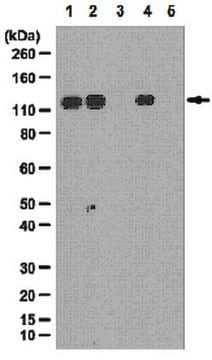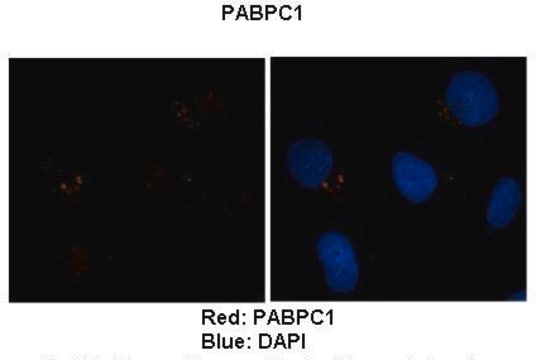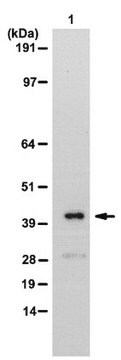04-1467
Anti-PABP 1 Antibody, clone 10E10
clone 10E10, from mouse
Sinónimos:
PABP 1, Poly(A)-binding protein 1, poly(A) binding protein, cytoplasmic 1, poly(A) binding protein, cytoplasmic 2, poly(A)-binding protein, cytoplasmic 2
About This Item
Productos recomendados
origen biológico
mouse
Nivel de calidad
forma del anticuerpo
purified immunoglobulin
tipo de anticuerpo
primary antibodies
clon
10E10, monoclonal
reactividad de especies
human
técnicas
immunocytochemistry: suitable
immunoprecipitation (IP): suitable
western blot: suitable
Nº de acceso NCBI
Nº de acceso UniProt
Condiciones de envío
wet ice
modificación del objetivo postraduccional
unmodified
Información sobre el gen
human ... PABPC1(26986)
Descripción general
Especificidad
Inmunógeno
Aplicación
Cited in Thoma, C., et al. (2008) RNA. 14:1579-1589, and Buchet-Poyau, K., et al.(2007) Nuc. Acids Res. 35:1289-1300 using a representative lot.
Immunocytochemistry:
Cited in Afonina, E, et al. (1998) J. Biol. Chem., 273: 13015-21 (1998) using a representative lot.
Epigenetics & Nuclear Function
RNA Metabolism & Binding Proteins
Calidad
Western Blot Analysis: 0.5 µg/ml of this antibody detected PABP 1 in 10 µg of HeLa cell lysate.
Descripción de destino
Ligadura / enlace
Forma física
Almacenamiento y estabilidad
Nota de análisis
HeLa cell lysate
Otras notas
Cláusula de descargo de responsabilidad
Not finding the right product?
Try our Herramienta de selección de productos.
Código de clase de almacenamiento
12 - Non Combustible Liquids
Clase de riesgo para el agua (WGK)
WGK 1
Punto de inflamabilidad (°F)
Not applicable
Punto de inflamabilidad (°C)
Not applicable
Certificados de análisis (COA)
Busque Certificados de análisis (COA) introduciendo el número de lote del producto. Los números de lote se encuentran en la etiqueta del producto después de las palabras «Lot» o «Batch»
¿Ya tiene este producto?
Encuentre la documentación para los productos que ha comprado recientemente en la Biblioteca de documentos.
Nuestro equipo de científicos tiene experiencia en todas las áreas de investigación: Ciencias de la vida, Ciencia de los materiales, Síntesis química, Cromatografía, Analítica y muchas otras.
Póngase en contacto con el Servicio técnico








